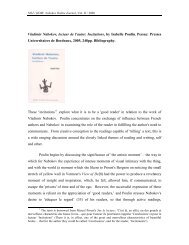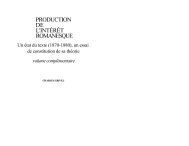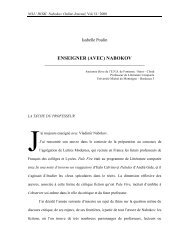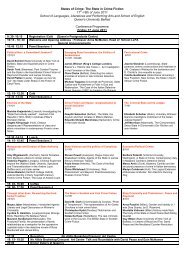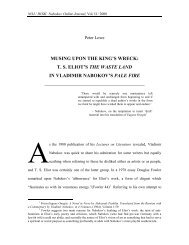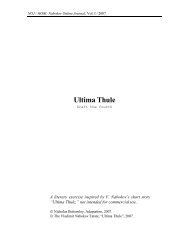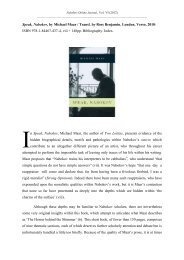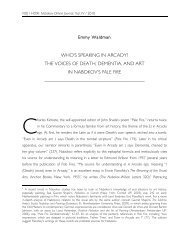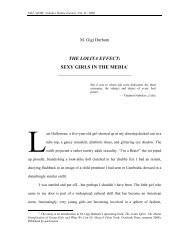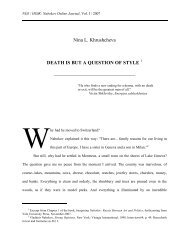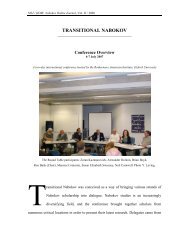domesticated translation: the case of nabokov's translation of alice's
domesticated translation: the case of nabokov's translation of alice's
domesticated translation: the case of nabokov's translation of alice's
Create successful ePaper yourself
Turn your PDF publications into a flip-book with our unique Google optimized e-Paper software.
N. Vid. “Domesticated Translation”<br />
original name-play. 6 This served as a pattern for creating a humorous effect and evoking<br />
certain associations.<br />
Almost all <strong>of</strong> <strong>the</strong> culture-bound elements related to proper names are<br />
<strong>domesticated</strong> to make <strong>the</strong>m fit into <strong>the</strong> Russian target culture. To achieve this aim,<br />
Nabokov drew on <strong>the</strong> whole repertoire <strong>of</strong> names existing in <strong>the</strong> Russian language. Thus,<br />
Alice was transformed into Ania, 7 a diminutive <strong>of</strong> a common Russian name, Anna. This<br />
decision is one <strong>of</strong> <strong>the</strong> most contentious, because <strong>the</strong> change <strong>of</strong> <strong>the</strong> girl’s name entails <strong>the</strong><br />
change <strong>of</strong> <strong>the</strong> title as well: Ania v Strane Chudes. Nabokov remains <strong>the</strong> only Russian<br />
translator in <strong>the</strong> twentieth century who changed <strong>the</strong> name <strong>of</strong> Carroll’s protagonist. All<br />
o<strong>the</strong>r translators have retained <strong>the</strong> name used in <strong>the</strong> original.<br />
In <strong>the</strong> second chapter, Alice loses her self-assurance and fears that she may have<br />
become “Ada” or “Mabel.” Nabokov retains <strong>the</strong> name “Ada” but replaces “Mabel” with<br />
“Assia,” emphasizing Alice’s doubts about her identity by establishing sound similarity<br />
between <strong>the</strong> names: Ania-Ada-Assia. “Mary-Ann,” <strong>the</strong> name <strong>the</strong> White Rabbit uses to call<br />
Alice, is replaced with “Masha,” ano<strong>the</strong>r popular Russian female name.<br />
Two o<strong>the</strong>r common names appear in <strong>the</strong> fourth chapter. Servants who work for<br />
<strong>the</strong> White Rabbit are named “Pat” and “Bill.” In <strong>the</strong> <strong>translation</strong>, Bill is replaced with<br />
Iashka (a colloquial diminutive <strong>of</strong> <strong>the</strong> Russian name, Iakov) and Pat with Pet’ka (a<br />
colloquial diminutive <strong>of</strong> <strong>the</strong> Russian name, Peter). Both <strong>of</strong> <strong>the</strong> colloquial diminutives<br />
signify <strong>the</strong> social position <strong>of</strong> <strong>the</strong> servants because in <strong>the</strong> Russian language diminutives <strong>of</strong><br />
personal names are usually used to express familiarity or, sometimes, even disrespect.<br />
Similarly, as Kibbee states, <strong>the</strong> name “Pat” has clear cultural connotation, being <strong>the</strong><br />
6 For instance, “Mock Turtle” was translated as “chepupakha” (Connloy 1995: 22).<br />
7 The first <strong>translation</strong> <strong>of</strong> Alice into Russian was entitled Sonia v strane Diva (1879).



